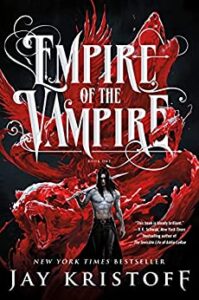
There is something strangely compelling about supernatural horror. A paradox of attraction that has sparked whole books intended to explain and examine. Thus, no surprise I find myself with an enduring fascination with such horror, especially where it intersects with fantasy or science fiction.
Several of my books feature vampires, and I’ve long planned a gothic horror series. I’ve read many I loved.
When I say this is the best vampire novel I’ve ever read (and one of my all time top fantasy novels), I do so as a fan of the genre. Kristoff manages to maintain the hint of sexual predations inherent in the vampire myth, while carrying these creatures out of the domain of romance and firmly back into monstrous territory. They have an irresistible allure, yes—but a dark one, driven by mankind’s fear and attraction to predators.
And the vampires presented with the novel are apex predators. The elder ones are undead gods against which mankind cannot hope to stand.
While mostly they attract people for the sake of their blood, the vampires do sometimes have sexual relations with humans. And sometimes these liaisons result in half-vampire paleblood abominations.
When the sun is blotted out by an inexplicable darkness—perhaps a permanent eclipse—the denizens of the dark gather. The main action of the novel is set a good number of years after the coming of “daysdeath,” and the empire of man is collapsing as undead horde of the Forever King claims city after city. All that stands in their way are the palebloods of the Ordo Argent, an order of Church-run saints who fight against their damned nature.
The premise evokes Blade, if such was set in a fantasy Gothic France. Gabriel de Leon is an apostate silversaint of the Ordo, who, when the novel opens, has succeeded in killing the invincible Forever King. He has been captured by another clan of vampires trying to step into the void he has created. The vampire interrogates Gabriel in search of the lost Holy Grail, and Gabriel begins relaying the story of his life, along two parallel threads.
Gabriel follows the non-linear approach as a means of delaying having to face the painful ends of each tale. The two timelines are both so compelling I could not possibly choose a favorite. The weaving of nonlinear storytelling, horror, and compelling character work was flawless.
Despite the length—and it was a long book that took me a while to get through—upon finishing, I found myself immediately wanting more. Gabriel’s tragic tale has saturated my consciousness, and I cannot stop thinking about it.
